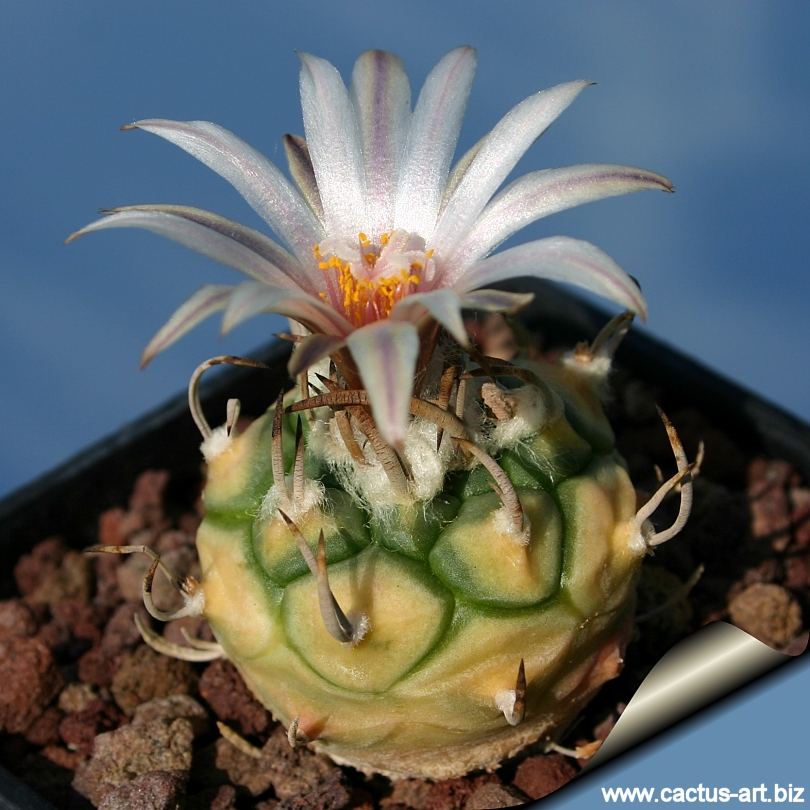|
|
|

T. schmiedickeanus variegata |
|
Description: Solitary or slowly clumping ,
dichotomy also observed, globular ± depressed,
30-50 mm high 35-40mm wide green, apex with some white wool.
Ribs: Completely divided into tubercles that are more or less
well-rounded to square to almost short, conical, 5 mm
wide at the base,
up to 7 mm long and pointing upwards, arranged in flat spirals.
Root: Taproot.
Areoles: On the tip of the tubercle, with a little wool, soon
becoming bare.
Spines: 3 (more rarely 4) the lower one
longer, up to 2,5 cm, the 2 side spines approximately 1/3 as short and
the upper, very often missing, still shorter, flattened below, curved
towards the apex and often contorted
grey, corky, rather soft, with transverse fissures. The spines are
persistent only on the upper body; below they fall off, and the body and
tubercles are corky and bare.
Flowers: Apical funnel shaped, whitish to pinkish, outside with
darker midribs 14-25 mm wide. This plant is capable of blooming
when it is little larger than 1 cm Ř.
|
|
|
|


Advertising
|
|
|
|
|
Family:
Cactaceae (Cactus
Family)
Scientific Name:
Turbinicarpus schmiedickeanus Forma
variegata |
|
Origin:
Garden origin (Nursery
produced cultivar) |
Conservation status: Listed in
CITES Appendix |
|
Variegation, albinism &
schizochromism.
Variegation: A variegated plant has sectors, patches or stripes
with two or more different colours, even distinct shades of green.
Plants with variegated stems or leaves are often
attractive and
highly prized.
In most species the
stems or leaves are normally green, and variegated epidermis is an
uncommon
mutation, termed a
chimera. A chimeral variegation is due to losing the ability to
produce
chlorophyll in some of the plant’s
tissue, so that this tissue is no longer green. Tissues lacking
chlorophyll are usually white or pale yellow coloured (due to
carotenoid
pigments) or red (due to
betalain or
anthocyanin pigments) contrasting with the normal green tissue.
There are several forms of variegation, depending on the tissues that
have been affected. The variegation in some forms is unstable. The
extent and nature of the variegation can vary, and sometimes the plant
will return to the green form. In others it is stable and does not
change under normal conditions. Because the variegation is due to the
presence of two kinds of plant tissue, propagating the plant must be by
a
vegetative method of
propagation that preserves both types of tissue in relation to each
other.
|
|
|
|
Cultivation: Variegated cacti are regarded as choice and difficult in cultivation,
but despite that many
of them are
relatively easy to grow. But be aware that
they cannot tolerate prolonged exposure to direct sun light (especially
during the hottest summer days), so grow them in half-shade or
under filtered sun. They are sometime seen as grafted plants, but
many grow well on their own roots, too.
On the contrary, the albinos can survive
only if grafted on a strong green base.
Use mineral well-permeable substratum with little organic matter (peat, humus). Water
sparingly from
March till October, and keep perfectly dry in
winter,
at temperatures from 5 to 15 degrees centigrade.
(In general these plants are more tender and cannot endure
freezing temperatures
). In
the rest period no high atmospheric humidity!!
Propagation: Almost usually by seed. Plants are often
grafted onto column-shaped cacti. Photo of
conspecific taxa, varieties, forms and cultivars of plants belonging to
the Turbinicarpus schmiedicheanus aggregate:
(This taxon has lots of synonyms,
with several controversial varieties and
subspecies):
|
|